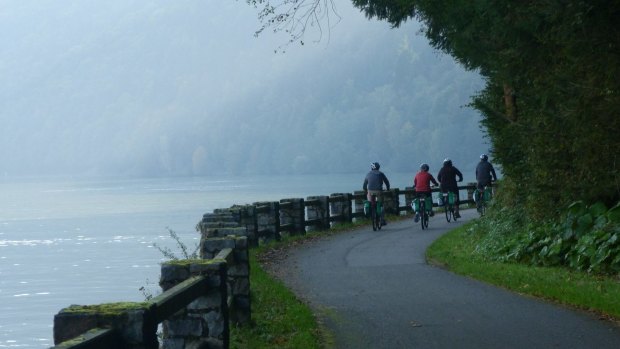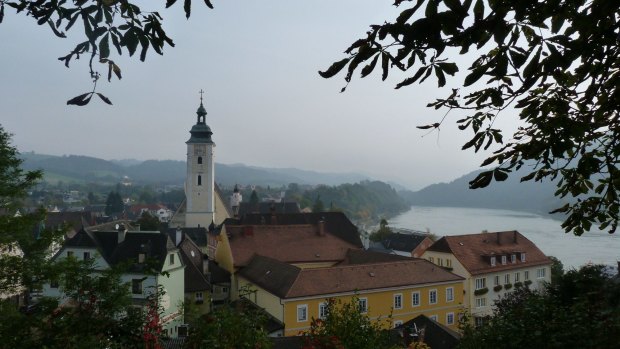This was published 9 years ago
Cycling the Blue Danube: Go with the flow
Richard Tulloch rides the Blue Danube cycle route.
By Richard Tulloch

Name only: The Danube wasn't blue, but there was plenty of colour on either side of its banks.Credit: Richard Tulloch
We cyclists hate stopping. When you stop pedalling a bike, it starts to wobble, then topples over. It takes far more effort to get a bike moving than it does to keep it rolling along at a steady speed.
That's why cyclists run red lights and ring angry bells at pedestrians blocking their bike path. It's also why, when enlightened planners lay several hundred kilometres of flat, smooth, wide, almost uninterrupted bike path along the iconic Danube River, we come in droves to roll along it.
The six-day stretch heading downstream from the German/Austrian border is one of Europe's most popular cycling routes. The Donauweg (Danube Way) glides over 350 kilometres of safe, signposted cycle path, through farmland and forests, villages and vineyards, finally arriving in Vienna.

Postcard: Grein is as beautiful up close as it seems from afar.Credit: Richard Tulloch
In the handsome German university town of Passau, I collect the bike that will be my companion for the coming week. It's a sturdy beast, with a comfortably padded saddle on which to place my comfortably padded backside. Technician Stefan gets me to road test it with a few loops of the carpark, and adjusts the 21 gears. I probably won't need most of them, but it's nice to know they're there.
Then I roll down the hill into Passau itself. The town is gently buzzing in the Friday afternoon sun. Young people crowd the outdoor terraces of the cafes in the Altstadt (old town) drinking dangerously large beers, while street musicians and jugglers do their thing. Bells chime in ancient clock towers. All seems well with the world.
My accommodation has been taken care of. This is a self-guided tour, meaning Australian adventure travel company UTracks, with their local Austrian partners, have booked me into hotels along the way and provided maps and detailed trip notes. They'll also pick up my luggage from the hotel foyer each morning and it will magically be reunited with me in the evening. All I have to carry is a camera and a rain jacket, and all I have to do is ride.
That's not difficult. The trip is rated introductory to medium, which means that anyone of reasonable fitness can manage it without difficulty. Hardcore riders may find it a little tame. In fine weather, the 50 to 70 kilometre stretches each day are very manageable, requiring only three to four hours of actual pedalling, even into a slight head wind. A rule known to all cyclists – there's always a head wind!
I can't help noticing that the "beautiful blue Danube" is not blue. Under cloudy skies it's more of a greenish-grey, though there's plenty of colour along its banks. In the early autumn the leaves are starting to turn red in the forests, corn crops are drying and there are occasional bursts of yellow from fields of sunflowers and canola. Across the river, white church spires and onion domes poke up from terracotta-tiled villages.
In Schloss Obernzell I join several of my fellow cyclists feigning an interest in pottery, Stone Age to contemporary, in the ceramics museum. What really attracts us is the toilet.
Toilet-finding is a perpetual problem for any traveller, and cycle touring presents an extra degree of difficulty. Wayside cafes offer facilities, though the decent thing is to drink kaffee in return for WC rights, thus perpetuating (sorry) a vicious cycle.
Navigation along the Danube is dead easy; just follow the river and you'll get there. Where there's a choice of roads ("north of the river" or "south of the river"), the trip notes suggest the safest, flattest, most traffic-free option. If there's not a bridge, there's a ferry, puttering back and forth for the benefit of pedestrians and cyclists.
The route is so well signposted that only a complete idiot who didn't pay attention could possibly take a wrong turn. I only get lost twice.
My German is limited, though even those with good marks in high school Deutsch would have trouble with the Austrian version. It's totally incomprehensible to me. It doesn't matter. In larger hotels my tentative "May I speak English with you?" is invariably met with "No problem, Sir."
Out on the road, wherever a welcome Gasthof (guesthouse) sign appears, the word for beer is "bier" and cappuccino is "cappuccino". I'm soon ordering wiener schnitzel in fluent Austrian.
Most of the cyclists I meet are older German and Austrian couples, some speeding past me on smart electric bikes. They're usually happy to exchange a few pleasantries with an Australian. But my ears prick up when I hear a familiar accent coming from a group of riders pausing for a photo op. I stop to chat, and am delighted to meet a family from Hobart. We arrange to ride together the following day. Thanks for the company, Merritts!
I spend a night in the tiny village of Ardagger Markt in an apple-growing area. Mine host at the Schiffmeisterhaus invites me to sample some "most" or local cider, a little sweet for my taste. Then he presses me to try his homemade apfelstrudel. No problem there. It's huge and covered in thick cream, a heart attack waiting to happen. I kid myself I'll cycle it off the following morning and tuck in.
It must be said that the Danube route is not universally beautiful. For every lovely schloss on a hillside there's a power station, warehouse or factory on the riverbank. Even attractive towns have nondescript outer suburbs. This is a working area. Fair enough. People have jobs and not all of them are about tourism.
Nonetheless, I sometimes find it disappointing to ride into a village that looked beautiful from a distance to find an ancient and potentially gorgeous town square marred by parking lots and pizza parlours. Don't they understand visiting cyclists have photos to take?
There are exceptions. The town of Grein is at least as attractive in close-up as it is when viewed across the river, and is renowned for its Stadttheater, which claims to have been in continuous operation since 1791. The theatre's wooden stalls are fitted with locks (in the past subscribers bought keys, rather than season tickets), the stage has a charmingly painted fire curtain, and I love the idea that there was once a hole in the wall through which prisoners from the adjoining gaol could enjoy the plays too.
Up the hill, Schloss Greinburg proves to be more than just "another bloody castle". The creepers draped over the arches in the courtyard are in full autumn colour. The view of the Danube beyond the town is worth the short steep climb.
Wine villages also know how to suck up to tourists and the Wachau region does it very well. Cycling over gently rolling hills with vines lining the road always makes me feel prosperous and pampered. If the narrow, cobbled streets of Durnstein are crowded with day-trippers from Vienna, there's good reason for it; the village is picture-postcard cute, the tasting is free and the local Riesling is particularly good.
I'm intrigued to see a line of bottles at a roadside stall. They're offering liqueur under an honour system; for a modest €1.50 you can help yourself to a slug of schnapps or marille, an apricot liqueur. I end up buying a bottle in the next town.
Things start to get really busy when we reach Melk. The Benedictine Monastery is crowded with groups spilling off the massive river-cruise ships. It certainly is elaborate, though whether all those frescoes and curly gold cornices are beautiful is a matter of taste. St Benedict himself apparently lived a life of simple discipline and asceticism.
For the final day's leg, I've been thoughtfully provided with a train ticket from Traismauer to Tulln, saving about 30 kilometres of cycling and allowing me to reach Vienna with time to look around that spectacular city.
I reluctantly say goodbye to my bike, leaving it in a dark corner of a hotel carpark for the truck to pick it up. I'm going to miss it.
I'll miss the Danube too. I'll miss the daily routine of huge guiltless breakfasts ("I'll cycle that third sausage off during the day") and hotel check-outs ("Nothing from the minibar? Enjoy your ride, Sir.") I'll miss my fellow cyclists and the knowing nods we give each other as we pass. I'll miss the steady "whiff-whiff" of my knees brushing the carry bag on the handlebars hour after hour.
I'm a cyclist. I don't like stopping.
The writer was the guest of UTracks.
TRIP NOTES
GETTING THERE
Trains from Vienna (Westbahnhof) to Passau leave about every two hours. The trip takes 2 hours 26 minutes and costs $70.
CYCLING THERE
UTracks' self-guided eight-Day Blue Danube Cycle tour, including bike rental, all accommodation, route maps, trip notes and luggage transfer starts at $1350. Upgrade options to 3- and 4-star hotels with dinners included. Bad weather is likely to make the ride an ordeal in winter. The best time is between April and October. Phone 1300 303 368; see utracks.com.
MORE INFORMATION
Five other gentle multi-day European rides:
1. Vienna to Bratislava, Slovakia and on to Budapest, Hungary (5-6 days)
2. The Loire Valley, France (4-5 days)
3. The Flemish Cycle Route, Belgium (10-14 days)
4. Lake Constance Loop, Germany, Austria and Switzerland, (5-6 days)
5. Zuiderzee Route, Netherlands (5-6 days)
All of these can be shortened by using trains or ferries for part of the route, or lengthened indefinitely by cyclists who just don't want to stop.
Sign up for the Traveller Deals newsletter
Get exclusive travel deals delivered straight to your inbox. Sign up now.